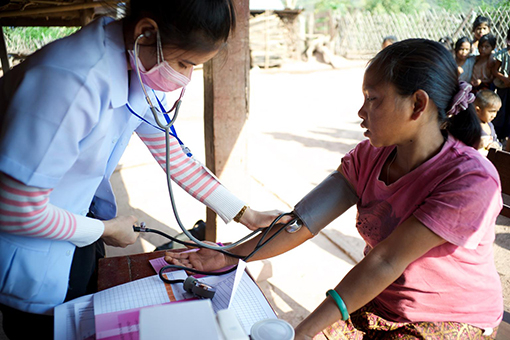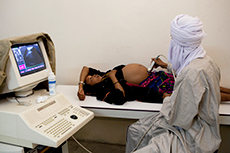More women worldwide receive early antenatal care, but great inequalities remain

WHO recommends that women start antenatal care at a gestational age of less than 12 weeks – this is referred to as ‘early antenatal care’. Early antenatal care is a critical opportunity for health providers to deliver care and support, and to give information, to pregnant women in the first trimester of pregnancy. Despite this, a recent study shows that many of the poorest women still do not have equal access to the high-quality early antenatal care that can help to ensure their health and well-being.
The recently published study, which was undertaken by staff at the WHO Department of Reproductive Health and Research including HRP, shows that while global coverage of early antenatal care has improved in the last 2 decades, substantial inequalities between regions and income groups remain.
Early antenatal care
Antenatal care – the routine care of pregnant women – is essential to ensure the best care and health outcomes for women and children. WHO’s antenatal care model recommends that all pregnant women should have eight contacts with a health provider throughout pregnancy. This should be initiated with a first contact at less than 12 weeks gestational age. This new model aims to provide pregnant women with respectful, individualized, person-centred care at every contact, with implementation of effective clinical practices (interventions and tests), and provision of relevant and timely information, and psychosocial and emotional support, by practitioners with good clinical and interpersonal skills within a well-functioning health system.
Globally, more than half of all women now receiving early antenatal care, but too many women are left behind
While the last 2 decades have seen an increase in the number of women receiving early antenatal care, in 2013 too many women living in developing regions did not receive early antenatal care. This is despite WHO’s recommendation that all women should initiate their first antenatal care contact in the first trimester of pregnancy.
Between 1990 and 2013, the estimated worldwide coverage of early antenatal care visits increased by 43%, to cover nearly 6 out of 10 women in the world. This is a significant improvement from 1990, when less than half of all women – only 4 out of 10 – were estimated to have received early antenatal care.
Despite this progress, less than half of all women in developing regions received early antenatal care in 2013. In contrast, the majority of women (an estimated 85%) in developed regions had an early antenatal care contact with a health provider.
In addition to inequalities between regions, the study showed significant gaps in 2013 between richer and poorer women. While the majority of women – an estimated more than 4 out of 5 women – in the highest income group studied accessed early antenatal care, an approximate 1 out of 4 women in the lowest income group accessed early antenatal care.
Most significant progress made in developing regions
In developing regions, where coverage has been especially low in the past 2 decades, the estimated coverage increased by as much as 74%, from including only 1 out 4 women in 1990, to nearly every other woman in 2013.
Many of the regions which had the lowest estimated coverage 2 decades ago, have since achieved an estimated increase in coverage of more than 70%, namely Northern Africa, Western Asia, Southern Asia, developing regions and South-Eastern Asia. All had an estimated coverage of below 45% in 1990.
In Northern Africa, Western Asia and Southern Asia, the estimated coverage more than doubled. In Northern Africa and Western Asia, where only around 3 out of 10 women were estimated to have received early antenatal care in 1990, the majority of women – 7 out of 10 – received this care by 2013. During the same period, the estimated coverage in Southern Asia improved from an estimated 2 out of 10 in 1990, to half of the women in 2013.
Detect and manage to prevent complications
Early antenatal care is a crucial moment for health providers to provide a number of screenings and tests, which are most effective early in pregnancy, including those which help to:
- correctly assess the length of pregnancy (gestational age) in order to allow for accurate treatment of preterm labour
- screen for genetic and congenital disorders
- provide folic acid supplementation in order to reduce the risk of neural tube defects
- screen and treat iron deficiency anaemia
- screen and treat sexually transmitted infections
- potentially capture non-communicable diseases such as diabetes
- potentially provide guidance on modifiable lifestyle risks such as obesity, malnutrition and occupational exposure

Lack of early antenatal care puts women and girls lives at risk
The estimates suggest that regions with low rates of early antenatal care coverage have high rates of maternal mortality. Two regions (sub-Saharan Africa and Oceania) showed an estimated coverage of less than 25% in 2013, and also had the highest ratio of deaths of women during pregnancy and childbirth, as well as the highest rates of stillbirths and deaths of newborn infants. The authors suggest that early antenatal care visits could potentially be linked with health outcomes for women and children.
Data and research needed to achieve universal coverage
More data are needed on early antenatal care in order to better inform policies and programmes which aim to improve health services for women, girls, and their families. At present, there is great variation between countries in terms of how and to what extent data on antenatal care is collected, and in many countries there are no data available. Increased efforts are therefore needed to improve the collection and reporting on early antenatal care contacts.
Specifically, more data is needed which is detailed by a range of demographic factors such as age, race, ethnicity and geographic location, as well as research which assesses the content and quality of antenatal care services. In addition, further research is needed on the underlying reasons why pregnant women do not begin antenatal care in the first trimester of pregnancy. This could help to inform interventions, adapted and appropriate to local settings, which ensure pregnant women and girls receive early antenatal care.
The goal: to end preventable maternal and child deaths
Equity is a prominent part of the 2030 Agenda for Sustainable Development, with its vision of a world with equitable and universal access to quality health care. Urgent action is needed to ensure that early antenatal care is available, accessible and acceptable; that all pregnant women initiate their first antenatal contact during the first trimester of pregnancy; and that that they receive optimal care and treatment throughout the pregnancy and childbirth.
.png)


